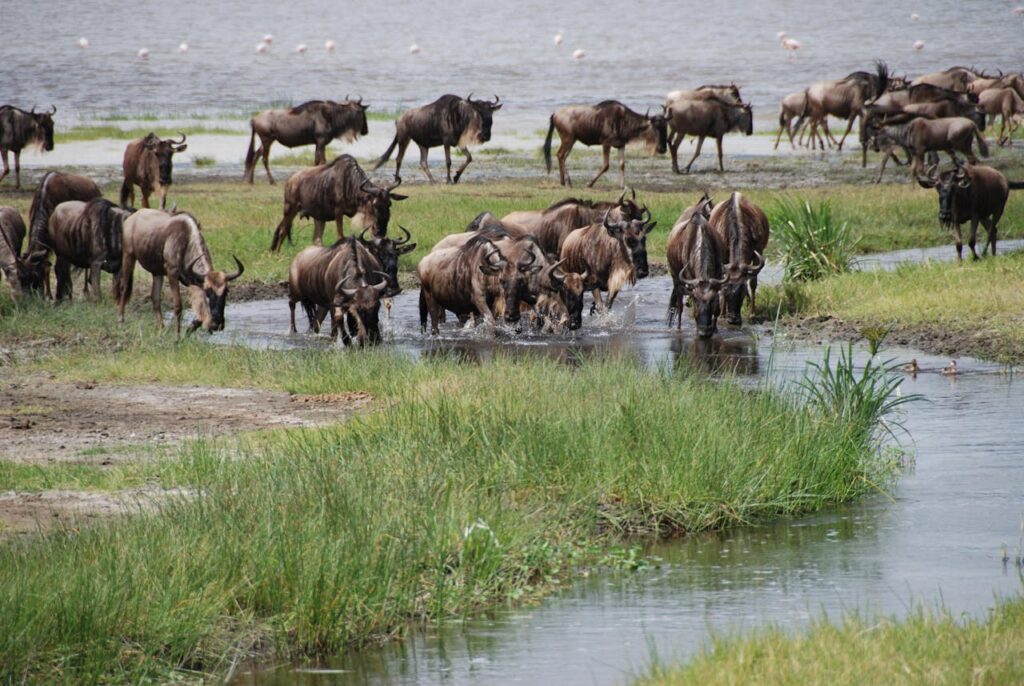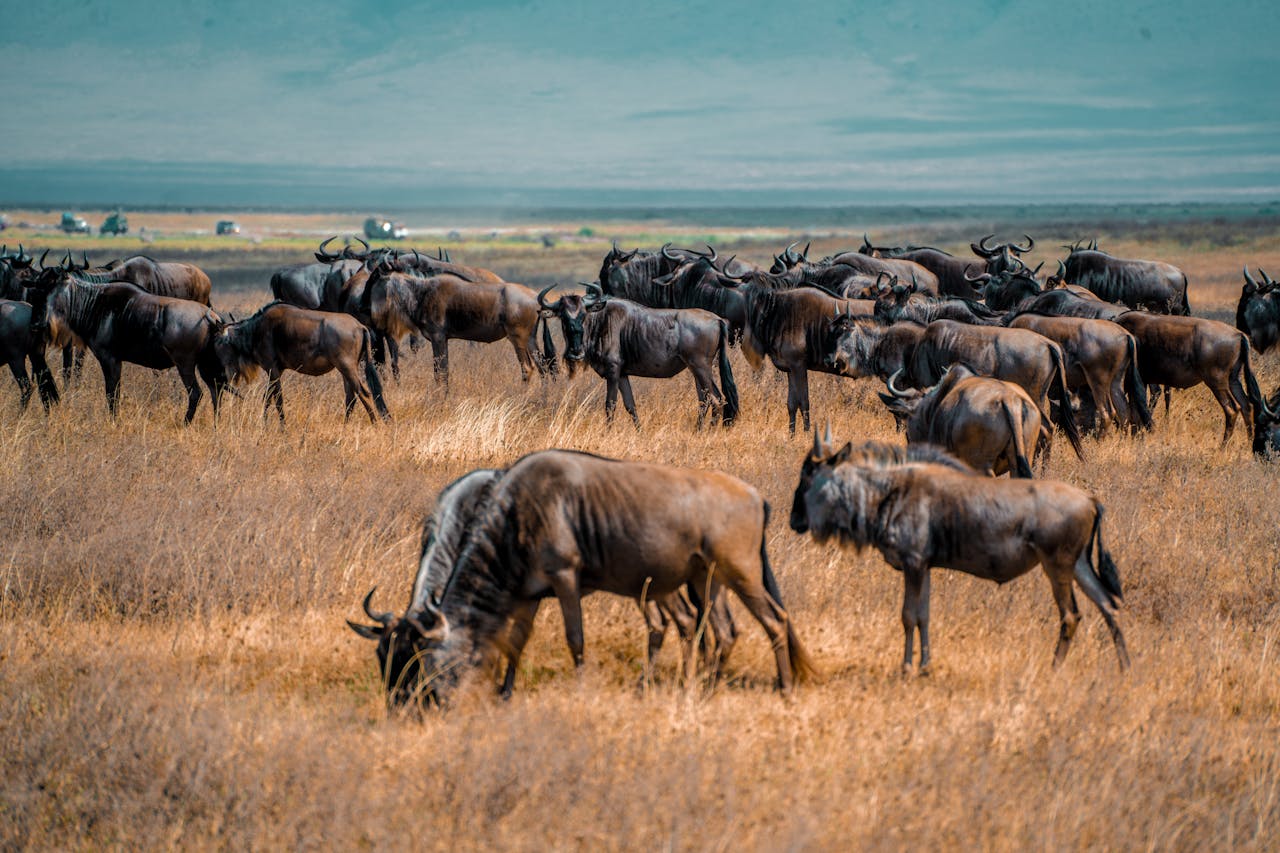Quick answer (if you want the short version)
The core season to see the Great Wildebeest Migration arrive in the Maasai Mara is July–October, with the most dramatic Mara River crossings typically between July and September. If you want quieter viewing with good wildlife variety (and lower prices), consider shoulder windows in June or late October–November.
Why timing matters
The Great Wildebeest Migration is not a single event but a rolling, weather-driven movement of roughly two million wildebeest, zebra and gazelle across the Serengeti-Mara ecosystem. Rain patterns, pasture, river levels and predator behaviour all influence where the herds are on any given day — which means timing affects what you’ll likely see: calving in the southern Serengeti, river crossings on the Mara River, or widespread grazing across northern plains. Planning your visit with month-by-month expectations maximises the chances of the experience you want.
Best months — at a glance
June: Herds move north; increasing chances of seeing migration streams approaching Mara. Good photography and fewer crowds.
July – August: Peak river-crossing season in many years — dramatic Mara River crossings, big cat action and full migration spectacle. Expect busy camps and premium rates.
September: Crossings can continue; animals spread through northern Mara and surrounding conservancies — superb predator sightings.
October – November: Migration animals may linger or begin to move back into the Serengeti; October often still offers migration action with smaller crowds compared to August.
December – May: Outside the Mara migration window. Excellent for general game viewing, calving season in the southern Serengeti (Jan–Mar) and lush green landscapes — fewer vehicles and lower rates.
Month-by-month guide — what to expect and why
January – February: Calving season (Serengeti)
If your primary aim is to witness newborn calves, predator-prey drama and intense action, January–March in the southern Serengeti is when hundreds of thousands of wildebeest calves are born. The Maasai Mara is calmer at this time; the main migration body remains in Tanzania. This is a superb season for dramatic wildlife behaviour — but not the river-crossing spectacle.
March – May: Green season — quieter, lush and birdy
These are the long rains months. Landscapes are greener and birdlife booms. Roads may be softer and some remote tracks less accessible; prices often fall and lodges have better availability. If you prefer fewer vehicles and rich scenery over migration spectacle, this is a good option.
June: Herds move north — shoulder-season advantage
By June the herds begin to move northwards from the Serengeti toward the Mara. This month is a great shoulder window: you get approaching migration action, good light for photography and lower crowds and prices than July–August. If river crossings are your primary goal, note they intensify later — but June is a smart compromise.
July – August: Peak migration and river crossings
This is the headline season. In many years the Mara River crossings — the most dramatic migration moment — occur from late July through August. Expect large numbers of vehicles in hotspot areas, exceptional photographic opportunities and adrenaline-fuelled river scenes with crocodiles and waiting predators. Book early (and consider fly-in options) — camps sell out fast.
September: Crossings continue & high predator activity
The herds can still be widely distributed across the Mara and northern Serengeti in September. Predator activity is high as the huge influx of grazers attracts lions, hyenas and cheetahs. September often combines good weather with slightly fewer crowds than August.
October – November: Late migration & quieter viewing
In many seasons the last stragglers move back or linger into October. November can see the beginning of the short rains and the migration pattern becomes more dispersed. If you want to combine migration sightings with quieter camps and lower rates than peak season, consider the tail end of the Mara window — but understand the movement becomes less predictable.
December: Dry weather returns for general game viewing
December delivers reliable weather and excellent general game viewing as the landscape dries. The Mara is busy with holiday traffic, but the migration spectacle itself has usually moved on. Good time to combine a safari with the Kenyan coast.

How to pick the right month for your priorities
If you want river crossings: Target July–August (book very early; consider conservancy camps with less vehicle density).
If you want fewer crowds & good photography: June or September balance sightings with calmer camps.
If you want dramatic predator & calving action: Visit January–March in the southern Serengeti (combine with a later Mara leg if you have flexibility).
If you want value & green landscapes: Go March–May (expect softer roads, fewer vehicles and lush scenery).
Practical considerations — crowds, price & logistics
Book early for peak months. July–September rooms and fly-in seats fill fast; secure your spot well in advance.
Vehicle density: Hotspots near the Mara River get very busy during crossings. If you prefer a more intimate experience, ask about small-group departures (Real Shangololo limits departures to max 5 guests) and camps in private conservancies.
Road vs air transfers: Road transfers are scenic but long (Nairobi → Mara ~4–6 hours by road); fly-in options reduce travel time and maximise game-drive hours.
Weather & river levels: River volume and rain patterns change yearly — the timing of crossings is not guaranteed. Always build flexibility into your trip plans.
Photography & packing tips for migration season
Lens choices: 70–200mm and 100–400mm recommended for private-vehicle photography; a wider 24–70mm helps with landscape and vehicle interior shots.
Stability: Bean bags and VR/IS stabilization are helpful in open vehicles.
Clothing: Neutral tones, layers for cool mornings, sun protection and dust-proof covers for gear.
Essentials: Binoculars, spare batteries & cards, a rain cover (for unexpected showers), and a small daypack.
Etiquette: Always follow your professional safari guide’s instructions on vehicle positioning and when to stop — safety first for you and the wildlife.
Where to stay & how to reduce crowd impact
Consider lodges/camps in conservancies adjacent to the reserve — they often provide excellent viewing while slightly reducing the busiest traffic around river crossings. Real Shangololo can suggest conservancy options and small camps that match your photography or privacy preferences.
For the most dramatic river-crossing scenes, position yourself near known crossing points (Mara River, Talek River) — but ask guides to time drives for early morning or late afternoon light when crossings are most photogenic.
Sample itineraries (fast picks)
5 days (focused): Fly-in Mara + two full days of game drives (peak months: Aug).
7–9 days (flexible): Mara + northern Serengeti circuit (best for river crossings & extended search).
10+ days (ultimate): Start in southern Serengeti (calving if Jan–Mar), then follow herds north into the Mara (if timing allows).
Ask Real Shangololo to create a bespoke itinerary — we specialise in intimate departures (max 5 guests) and can tailor transports, timing and lodge choices to maximise migration viewing.
FAQs
Can you guarantee a Mara River crossing?
No operator can guarantee a crossing. River levels and herd movements are natural and unpredictable. Guides use real-time sighting networks to improve your odds, but be prepared for flexible routing.
When is the cheapest time to visit the Mara?
The green/low season (March–May) typically offers the best value, but expect limited road access in heavy rains.
What’s the best way to avoid crowds?
Book small-group departures, stay in conservancies rather than the busiest reserve camps, and travel in shoulder months (June or September).
Final notes & action steps
If the Great Wildebeest Migration is your top goal, target July–September and book as early as possible. If you value small groups and photographic space, tell us your priorities — Real Shangololo runs max-5-guest departures led by licensed professional safari guides and can recommend flight options, conservancy camps and the best timing for your travel window.
Ready to plan? Check availability and secure your dates: Check Dates & Book — or Request a bespoke migration itinerary and we’ll tailor transport, guiding and lodge options for you.

